Golden boy: Inside James Hird’s life, career, controversies
Seven years after he walked away from the Bombers in the wake of the messy supplements scandal, James Hird eyed a return to Windy Hill. But it wasn’t to be. We take a look at the life and times of one of football’s most divisive characters.

Sport
Don't miss out on the headlines from Sport. Followed categories will be added to My News.
The best part of a decade after leaving the club following a troubled stint as coach, Bombers great James Hird is eyeing a return to the top job at his beloved Essendon, although as Mark Robinson reports, that dream appears to be slipping further out of reach.
Despite being a somewhat divisive figure, in light of the notorious supplements scandal, Hird remains an unimpeached champion of the game, with a string of accolades against his name as a player, and the support of those who believe the 49-year-old now deserves a shot at redemption.
It’s been a bumpy ride for the two-time premiership captain. We take a look back at where Hird’s football story began and what the next chapter might look like.
FAMILY HISTORY
James Albert Hird was born in Canberra on February 4, 1973.
Speaking in 2013 about the significance of the Anzac Day game that would become such a fixture of his life with Essendon, Hird also talked about what it was like to grow up in the nation’s capital - the centre of Australia’s annual Anzac Day commemorations.
“My house in Canberra was the closest house to the War Memorial, so Anzac Day was always huge. You had the big march, and from a young kid, you went and watched the march up Anzac Parade. Then, when I think back to ‘95, we played footy on Anzac Day.
“It has always meant a lot because I’ve been around it all my life.
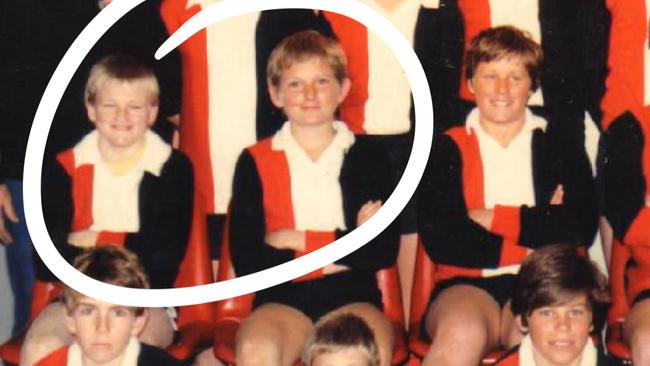
Hird’s grandfather, Allan Hird Sr, was also a premiership player for the Bombers, reserves coach, club president and executive in the then-VFL.
Hird’s father Allan Hird Jr also played for Essendon and went on to become the president of the AFL in Canberra. Hird’s mother, Margaret, was a school principal.
Hird was a skinny kid who did ballet at school, but as Andrew Rule wrote in 2013 “there was a fighter inside” - a fact he demonstrated again and again throughout his playing career.
Hird played junior football with Ainslie in the ACT, including alongside former Collingwood great Nathan Buckley in the U13s.
PERSONAL LIFE
Hird married Tania Poynton in 1997 and the couple have four children, a daughter, Stephanie, and three sons, Alex, Tom and William. Tom and Alex, were signed by Essendon as part of the club’s junior development academy, which is named after their father, while William also has ties to the academy. Tom was cut by Essendon in August, 2022. Stephanie joined the Bombers’ VFLW side in 2017 when the club was vying to join the AFLW.

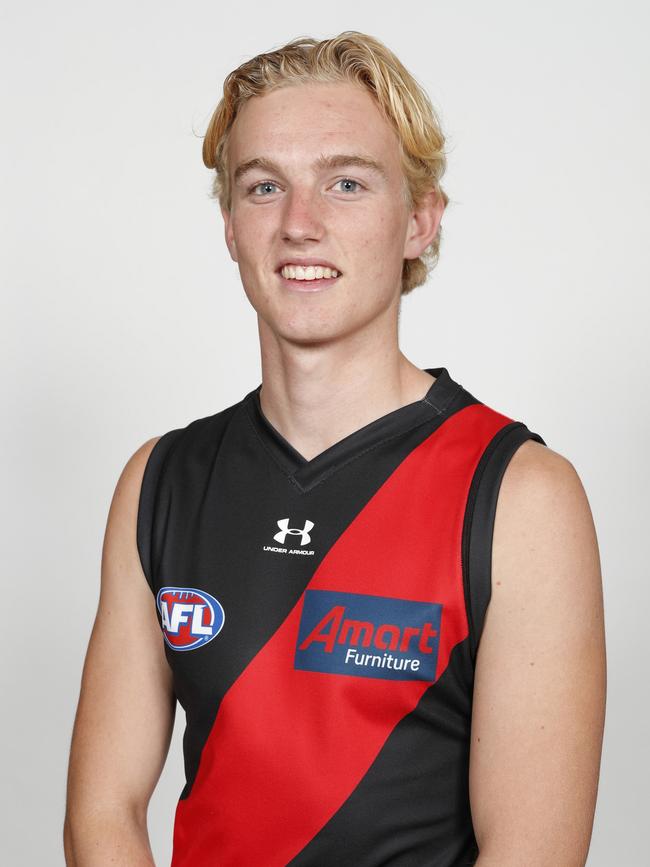
EARLY YEARS
As veteran Herald Sun reporter Andrew Rule wrote in 2013, as a young man about to embark on a sporting career on the national stage, Hird’s formidable intelligence, “ferocious determination and self-believe” set him apart from most young footballers his age.
His taste for the finer things in life also set him apart from the rest of the pack.
As Rule writes, whereas most players favoured jeans and T-shirts, Hird, according to someone who knew him at the time, “had a room full of suits - at least 50 of them”.
He was voted one of Melbourne’s best-dressed men.
Hird also drove prestige cars that came from a panelbeating business he’d invested in.
“Gentleman Jim was always more Wall Street than Puckle St,” Rule wrote.
SHAKY START IN THE AFL
While it didn’t take him long to establish his bona fides as a champion player, it’s easy to forget that Hird’s ascension to the AFL wasn’t exactly a dream ride.
A lot of people forget he had to work hard,” legendary Bombers coach Kevin Sheedy, who brought Hird to Essendon, said in 2013.
“He was pick 70 in the draft or something - it was tough for him.”
In fact, Hird was drafted with pick 79 in the 1990 draft and in 1991 was nearly dumped altogher but for a reprieve from Sheedy, who saw Hird’s grit and determination.
As Rule writes, Hird carried injuries from his school football career into the ALF and struggled to get a game in his first season.
As Ben Broad observed in 2018, Hird was “lightly-framed but blessed with amazing balance and bravery” and could play any position on the ground but was best in the midfield and across half-forward.
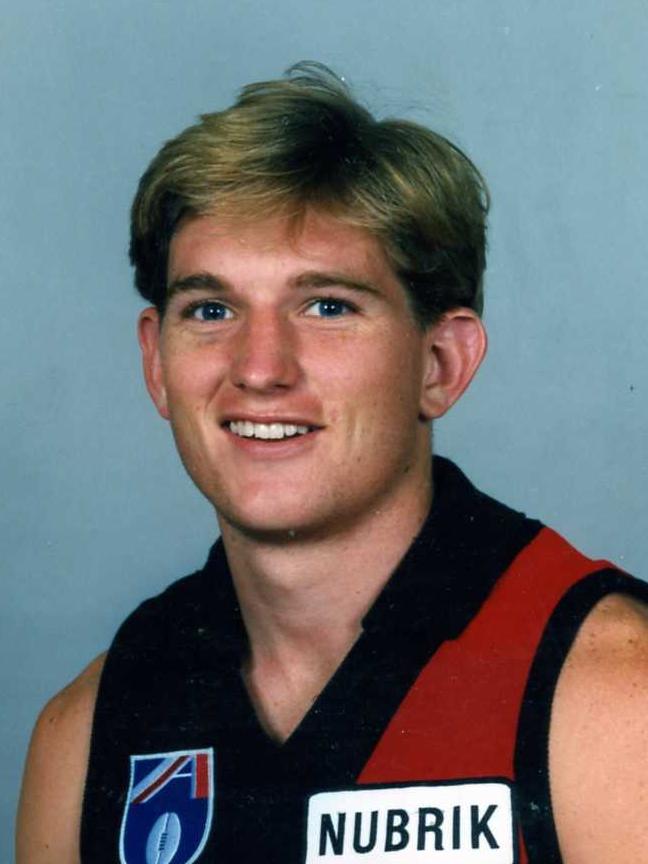
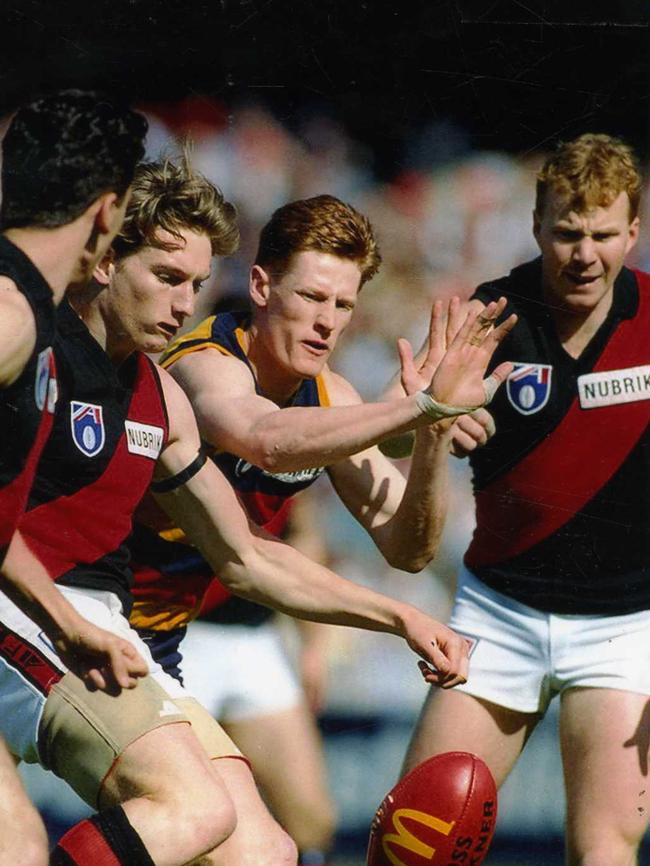
HIRD FINDS HIS FEET
By the early 1990s, Hird was an Essendon regular and in 1994 picked up for the first of five career Best and Fairest medals and the first of three consecutive medals.
In 1996, Hird shared the Brownlow with Brisbane’s Michael Voss.
In 2020, he told The Herald Sun a five week trip across Europe with partner Tania, who would later become his wife, in 1995, during which he trained solo every morning, helped him jump into the 1996 season “as fresh as a daisy”.
That season is regarded as one of the finest individual seasons in Bombers history.
Hird was named captain of the side in 1998, but a foot injury in 1997 plagued the 24-year-old for the next three years and threatened to cut short his budding career.
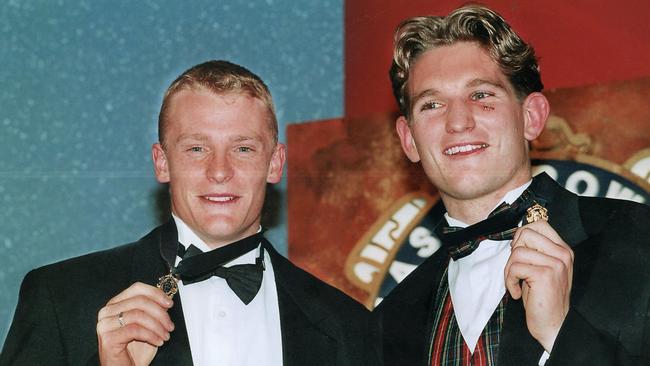
As Andrew Rule writes, in 1999, Hawthorn great Dermet Brereton “mischievously” suggested that Essendon had made a dud investment in Hird, who, as a result of his nagging foot injury, had barely played in months.
But the doubters had underestimated that grit and determination Kevin Sheedy spoke of.
“Hird was willing to back his own judgment, abandoned the conventional treatment and went to the US for a radical procedure,” Rule wrote.
“He did whatever it took and it worked.”
Hird made a stunning comeback, playing 20 games for the season - the most since 1996 - and captaining the Bombers to the flag in 2000.


He collected the Norm Smith medal for his best on ground performance.
Hird backed up his comeback with a strong 2001 season, leading the Bombers, again, to a Grand Final, in which they were beaten by Brisbane.
In 2002, Hird suffered a serious facial injury when he copped a knee to the head but again, found his way back to form.
He stepped down from the captaincy in 2006 and played his final season in 2007, capping his playing career with his fifth Best and Fairest award.
HIRD HANGS UP THE BOOTS
In 2008, Hird took up a job as analyst on Fox Footy.
But in an interview with friend Shane Crawford in 2020, Hird revealed that leaving his playing career behind was a much more difficult process than he anticipated.
“I thought I would transition out of footy and into this business ( a venture he was part of) and I wasn’t going to miss it,” Hird said.
“I remember sitting on my kitchen floor and everyone’s gone to bed, my wife’s upstairs, the kids are in bed, and I am sitting there, just crying on the ground,” he said.
“As much as I was glad to retire because I’m sick of being sore… there was this grieving process.” In 2010, Hird was appointed senior coach at Essendon.
THE SUPPLEMENTS SCANDAL
It was the bombshell that would spell the beginning of the end of Hird’s coaching reign at his beloved Essendon.
In February 2013, a dramatic press conference drew attention to aspects of the five main sporting codes that no-one wanted.

Two days earlier, Essendon announced it had self-reported to ASADA and the AFL to investigate concerns around the potentially inappropriate use of supplements at the club during the 2012 season.
The club stood down fitness coach Dean “The Weapon” Robinson, who, in an explosive TV interview claimed he had been asked to conduct “black ops” at the club.
Essendon said Robinson’s claims were “totally without foundation”.
The Bombers were disqualified from the 2013 finals, fined $2m and stripped of its picks in the first two rounds of the 2013-2014 national drafts.
Hird also accepted a 12-month ban from his coaching role
In late 2014, Essendon paid Robinson $1m for unfair dismissal.
In June, 2015, the club’s former sports scientist Stephen Dank was handed a lifetime ban for his role in the saga.

In March 2014, Hird told Essendon’s Fox Footy Show The Hangar he was “counting down the days” to his return to coaching.
“I think it’s less than six months now to come back and I can’t wait to come back and coach this football club again and coach the players and reward the supporters for the faith they have put in our football club,” Hird said.
In August, 2015, with Essendon languishing at 15 on the ladder, Hird resigned saying he hoped his departure would enable the club to focus on the main game - playing football.
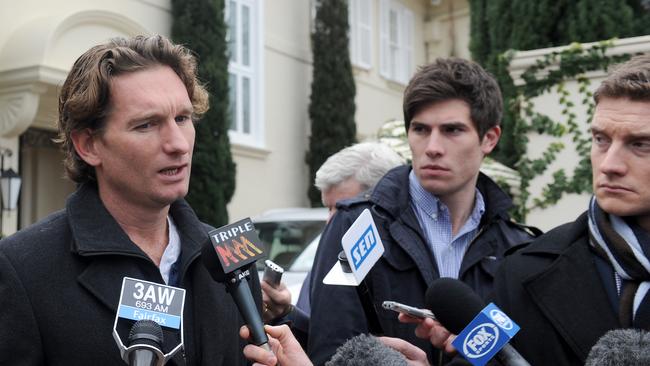
“We want to be a football club, not at the centre of media circus,” Hird said.
“By leaving, I hope it will allow them to go back to being a football club,” he said.
“I believe the club needs the ability to get some space; I hope that me going allows the club to get some space.”
‘MY GREATEST WEAKNESS’
Speaking on a podcast in July, 2022, Hird maintained the players were innocent victims of the club’s supplements regimen.
“The thing that is the most upsetting is there’s 34 players who have done absolutely nothing wrong and their families and them have suffered hugely for it – and so have the Essendon supporters. These people have been the most loyal supporters of all time,” Hird said.
He said his greatest weakness was that he had been too “trusting” of others at the club.
“I should have been over more of the detail,” he said.
MENTAL HEALTH STRUGGLES
In 2017, Hird spent five weeks in a psychiatric hospital battling depression after the stress of the supplements scandal pushed him to the brink.
On a podcast with Shane Crawford in 2018, Hird said his depression had been “debilitating” but he was not embarrassed to speak openly about his struggles.
“There are a lot of things in my life that I want to keep very quiet; my family and things like that.“But that part of my life, for some reason, I don’t think it needs to be private and I need to talk about it, about the effects it had on me and other people.”
Discussing the topic again in July 2022, Hird said he was finally back to a point where “life is good”.
“I’m not proud of what happened but I am proud of the resilience that I have to actually get to where I am,” he said.
“To me it was, ‘This is the bottom of the pile’. No matter what they throw up I’m going to keep climbing and climbing.
“You can get up and see life is good. While you’re going through those dark moments, you’re climbing through darkness. But as long as you keep moving, you’re not going backwards.”
UNUSUAL CAREER MOVE
In 2019, Hird revealed he had been working as a broker in the sale of huge sporting clubs in the UK and Europe, including ‘a very small piece of work’ around the sale of the Italian club Inter Milan. Hird also worked as an ambassador for Aussie boot company Concave, helping to raise its profile in China when they signed the best player in the country.
RETURN TO FOOTBALL
In January, 2022, Hird made a return to football, taking up a part-time leadership role at Greater Western Sydney.
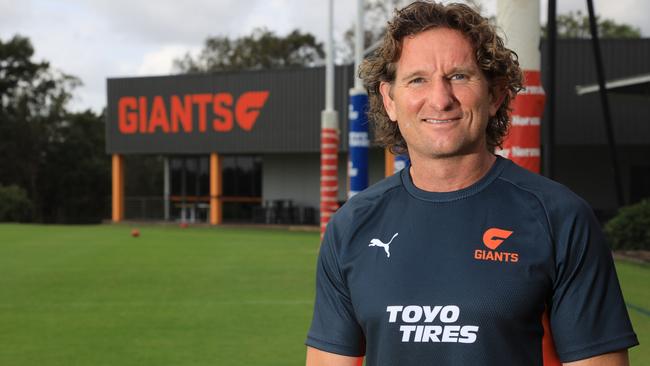
RETURN TO ESSENDON?
In 2020, the man who helped bring Hird to Essendon all those years ago said he would welcome the Canberra kid back to the club at any time.
Speaking in July, before the Bombers sacked senior coach Ben Rutten, Hird said he was keeping the door open to a possible return to a coaching role.
“I was asked by the CEO of a club six weeks ago if I’d like to coach – not his club – but if I’d like to coach again,” Hird said.
“My honest answer was, ‘There’s some elements about it I really like (but) I’d have to have family considerations to do it’.
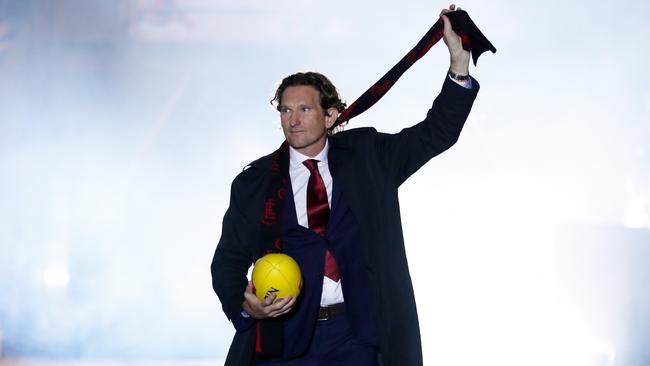
“I love the fact that you get in deeply and you work with young people to create something really, really special and you create a great team environment.
“But I’ve worked very, very hard over the last six years to create another business arm and I’m 50. At 40, when it happened I could transition and go.
“At 50, you go down (that path) and that’s almost it. So I’d have to think very carefully about the path that I take and there has to be an opportunity too, obviously.”
Hird has clearly been thinking very carefully.
In September, 2022, he officially threw his hat into the ring to get his old job back. Watch this space.



